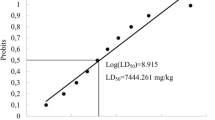Abstract
1-(hydroxymethyl)-5,5-dimethylimidazolidine-2,4-dione (MDM hydantoin) is a commonly used antiseptic preservative in cosmetics. However, limited toxicity information data are available for this chemical. The aim of this study was to obtain toxicity data for MDM hydantoin through single- and repeated-dose toxicity studies in Sprague–Dawley (SD) rats. In the single-dose toxicity study, MDM hydantoin was administered once orally to SD rats at four doses (5, 50, 300, and 2000 mg/kg/day). There was no significant difference in mortality, clinical signs, and body weight change for 14 days among the animals treated with the different doses in this study. Hence, the approximate lethal dose of MDM hydantoin was considered higher than 2000 mg/kg/day. Based on the results of the dose-range finding study, a 28-day repeated-dose oral toxicity study was conducted. MDM hydantoin was administered orally to SD rats at doses of 125, 250, 500, and 1000 mg/kg/day throughout an experimental period of 28 days. In the repeated-dose oral toxicity study, the adverse effects caused by MDM hydantoin were not detected in terms of body weight, clinical signs, food and water intake, hematology, organ weights, gross pathology, and histopathology. Therefore, the no-observed-adverse-effect level of MDM hydantoin was considered to be greater than 1000 mg/kg/day.



Similar content being viewed by others
References
The Ministry of Food and Drug Safety (2017) Regulation on safety tandards etc of cosmetids. The Ministry of Food and Drug Safety, Osong
Kireche M, Peiffer JL, Antonios D, Fabre I, Giménez-Arnau E, Pallardy M, Lepoittevin JP, Ourlin JC (2011) Evidence for chemical and cellular reactivities of the formaldehyde releaser bronopol, independent of formaldehyde release. Chem Res Toxicol 24:2115–2128
IARC (2004) Working group on the evaluation of carcinogenic risks to humans. World Health Organization International Agency For Reserch On Cancer, France
Kireche M, Gimenez-Arnau E, Lepoittevin JP (2010) Preservatives in cosmetics: reactivity of allergenic formaldehyde-releasers towards amino acids through breakdown products other than formaldehyde. Contact Dermatitis 63:192–202
de Groot AC, Veenstra M (2010) Formaldehyde-releasers in cosmetics in the USA and in Europe. Contact Dermatitis 62:221–224
Cahill J, Nixon R (2005) Allergic contact dermatitis to quaternium 15 in a moisturizing lotion. Australas J Dermatol 46:284–285
Chen X, Sullivan DA, Sullivan AG, Kam WR, Liu Y (2018) Toxicity of cosmetic preservatives on human ocular surface and adnexal cells. Exp Eye Res 170:188–197
de Groot AC, van Joost T, Bos JD, van der Meeren HL, Weyland JW (1988) Patch test reactivity to DMDM hydantoin. Relationship Formaldehyde Allergy Contact Dermatitis 18:197–201
Uter W, Frosch PJ; IVDK Study Group and the German Contact Dermatitis Research Group, DKG (2002) Contact allergy from DMDM hydantoin, 1994–2000. Contact Dermatitis 47:57–58
The Ministry of Food and Drug Safety (2017) Toxicity test standards of medicine and medical supplies. The Ministry of Food and Drug Safety, Osong
Fasth IM, Ulrich NH, Johansen JD (2018) Ten-year trends in contact allergy to formaldehyde and formaldehyde-releasers. Contact Dermatitis 79:263–269
de Groot A, Geier J, Flyvholm MA, Lensen G, Coenraads PJ (2010) Formaldehyde-releasers: Relationship to formaldehyde contact allergy. Metalworking fluids and remainder. Part 1. Contact Dermatitis 63:117–128
de Groot A, Geier J, Flyvholm MA, Lensen G, Coenraads PJ (2010) Formaldehyde-releasers: relationship to formaldehyde contact allergy. Part 2: metalworking fluids and remainder. Contact Dermatitis 63:129–139
Thyssen JP, Engkilde K, Lundov MD, Carlsen BC, Menné T, Johansen JD (2010) Temporal trends of preservative allergy in Denmark (1985–2008). Contact Dermatitis 62:102–108
Aalto-Korte K (2000) Simultaneous allergic reactions to quaternium-15 and methenamine. Contact Dermatitis 42:365
Cahill JL, Nixon RL (2011) Allergic contact dermatitis in health care workers to diazolidinyl urea present in antimicrobial hand gel. Med J Aust 194:664–665
Nair AB, Jacob S (2016) A simple practice guide for dose conversion between animals and human. J Basic Clin Pharma 7:27–31
Reigner BG, Blesch KS (2002) Estimating the starting dose for entry into humans: principles and practice. Eur J Clin Pharmacol 57:835–845
Lee J-M et al (2012) Historical control data from 4-week repeated toxicity studies in Crj:CD (D) rats. J Exp Biomed Sci 18:268–275
Acknowledgements
This work was supported by a grant from the Ministry of Food and Drug Safety (grant number 18181MFDS362 [2019]).
Author information
Authors and Affiliations
Corresponding author
Ethics declarations
Conflict of interest
The authors declare that they have no conflict of interest.
Rights and permissions
About this article
Cite this article
Won, H., Lee, J.H., Seok, JH. et al. Single- and repeated-dose 28-day oral toxicity study of MDM hydantoin in Sprague–Dawley rats. Toxicol Res. 37, 59–69 (2021). https://doi.org/10.1007/s43188-020-00055-0
Received:
Revised:
Accepted:
Published:
Issue Date:
DOI: https://doi.org/10.1007/s43188-020-00055-0



